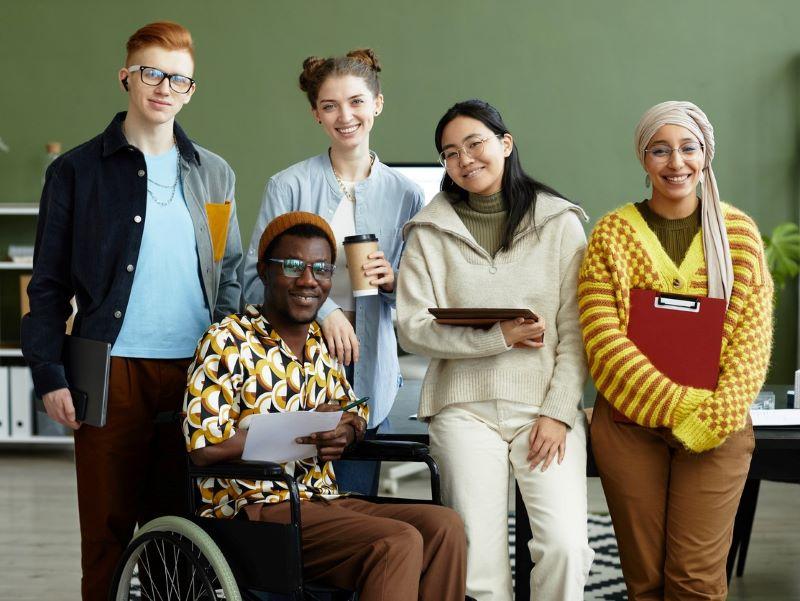Universities play a key role in supporting the development of more inclusive societies. However, disability inclusion, promoting equal access and equal opportunities for all disabled students to do well, is the poor relation in higher education inclusion work.
While diversity is known to positively impact organisational outcomes, not all aspects of diversity are treated equally. Disabled students have poorer access to university, are more likely to drop out, have lower degree results and worse employment outcomes than non-disabled peers.
Aggregated disability data provides a limited and often misleading picture of the scale of the issue. For example, on the surface, national statistics for English higher education suggest a 1.1 per cent attainment gap between disabled and non-disabled students. But when disability types, ethnicity, gender, socio-economic variables, institution, discipline of study, profession, mode of study (ie, part or full-time) are factored in, the real scale of the issue becomes apparent.
- Where are the leaders with a disability in higher education?
- We can help students with intellectual disabilities shatter glass ceilings
- Online alone is not the answer – how to design remote courses with accessibility and inclusivity in mind
For example, the gap in attainment for part-time disabled students with cognitive or learning difficulties within higher education in England is 9.5 per cent lower than their non-disabled peers. This is likely to be much higher when combined with the challenges associated with ethnicity, social class and gender.
The data does not expose the physical and emotional toll on disabled students in trying to navigate higher education, which impacts opportunities to realise potential. Disability is personal, complex and fluid. People are disabled by their bodies and by organisational and societal constraints.
However, the importance of institutional approaches to disability inclusion came through loud and clear from a systematic review of disability inclusion examining more than 600 peer reviewed articles and expert reports from a data set of approximately 11,000, including discussions with expert stakeholders. This led to the development of the Disability Inclusion Institutional Framework or DIIF for short (Figure 1).
The DIIF highlights the importance of promoting disabled student and staff self-advocacy, and the role of higher education providers in facilitating this. It is organised around 12 interrelated themes – see the downloadable document above – under three overarching constructs:
Shared Ownership: disability inclusion as the responsibility of all
Empowerment: focused on enabling access and addressing the physical and emotional labour involved in advocating for basic needs
Independence: enabling disabled students and staff to have equal access to resources to manage their HE contexts for themselves.
Disability inclusion cannot be treated as an “add-on”. It needs to be integral to higher education provision. From the research, it is possible to identify big ticket items that can substantially impact inclusion for all and ensure the fundamentals of disability inclusion provision are addressed.
Using the DIIF themes, which need to be looked at in unison, key considerations in moving forward are:
1. Embedding disability inclusion into performance review for all. If we are serious about disability inclusion it needs to become part of the lifeblood of organisations and the responsibility of all.
2. Providing a centralised resource base on disability inclusion signposting high-quality research and opportunities for staff and students to research disability inclusion and mobilising this research to leverage practice within universities and with all stakeholders.
3. Making better and more agile use of data to inform disability inclusion as part of module reporting. Module leads need to be provided with the data dashboards and training in them. Attention should be focused on the intersections of disability with other variables that impact access and success such as ethnicity and socio-economic status.
4. Building disability inclusion capacity within disciplines using specialist support as part of team-based design and especially regarding the first semester experiences of disabled students.
5. Capturing the lived experiences of disabled students or staff does not require complex methods, it is about asking focused questions that get to the heart of the experience and at key points in time.
6. Ensuring basic access. Valuing diversity needs to translate to disabled student and staff experiences on the ground. Providing all staff and students with a route map of what supports are available matters, along with judicious evaluation of the quality of them.
7. Disability awareness training needs to be embedded within all training opportunities.
8. Enabling disabled staff and students’ ownership of the disclosure process, and reducing the administration burden so that the emotional and physical cost of managing disclosure and related processes are reduced.
9. Simplifying what an inclusive curriculum is and encouraging an institutional focus on specific evidence-based constructs in relation to context. Embedding reasonable adjustments in design of assessment tasks from the outset and encouraging students to produce accessible outputs as part of assessment are important.
10. Mainstreaming assistive technologies (ATs) and providing the training for staff and students in these tools with judicious management of the quality of it. Focus should be on what are the most effective tools in specific contexts and providing training in good time to enable all to maximise the benefits.
11. Focused and early transitions support in (i) working with students, their parents and teachers in schools to ensure they have the skills and knowledge to navigate disability inclusion processes in higher education; (ii) promoting academic and professional mentoring, early internship opportunities, and access to wider academic and social networks to support effective transitions into the work or further study.
12. Sharing the advocacy load: providing disabled staff and students with the tools to advocate effectively while minimising their need to do so by ensuring accessibility is integral to design from the outset and working collectively to address barriers to inclusion. For example, changes in scheduling that are unworkable for those with multiple and complex needs; late arrival of equipment and lack of training in how to use it.
The full DIIF checklist provides a detailed breakdown of key considerations that are important in promoting disability inclusion for students and staff at institutional, faculty and individual levels. Establishing clear principles of disability inclusion is a must, as is ensuring alignment between the evidence and focus of approaches to ensure best use of resource. The evidence base was especially weak around inclusive learning and teaching given the fuzzy nature and different interpretations of it. This latter point highlights the need to be (a) explicit about the focus of disability inclusion initiatives, and (b) comprehensive in embedding them at scale using a less is more approach.
Carol Evans is an honorary visiting professor at Cardiff University and visiting professorial fellow at the University of Southampton.
Xiaotong Zhu is a research fellow at the Eleanor Glanville Institute, University of Lincoln.
If you found this interesting and want advice and insight from academics and university staff delivered direct to your inbox each week, sign up for the THE Campus newsletter.




comment